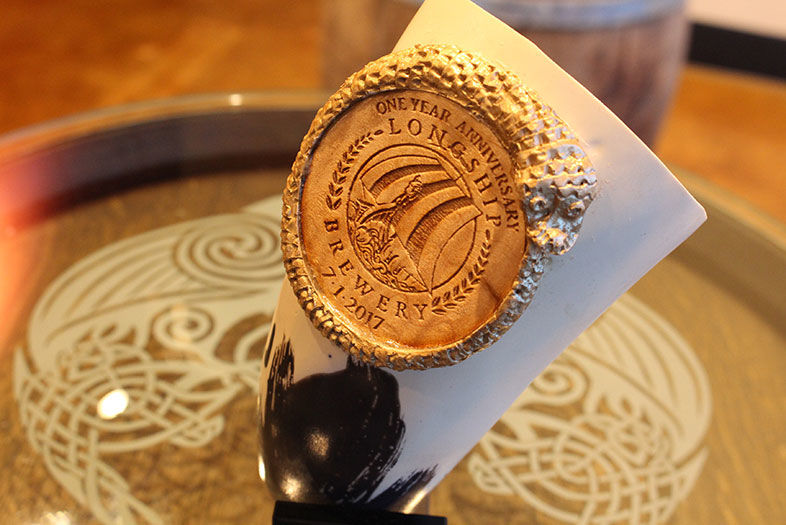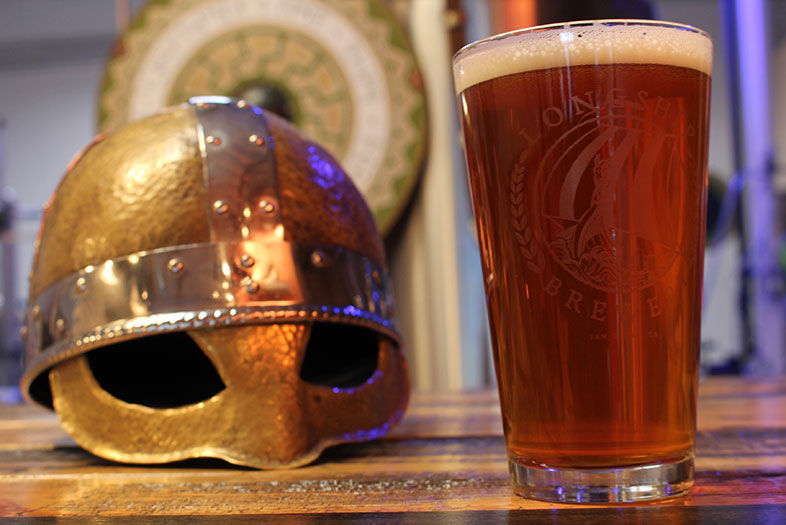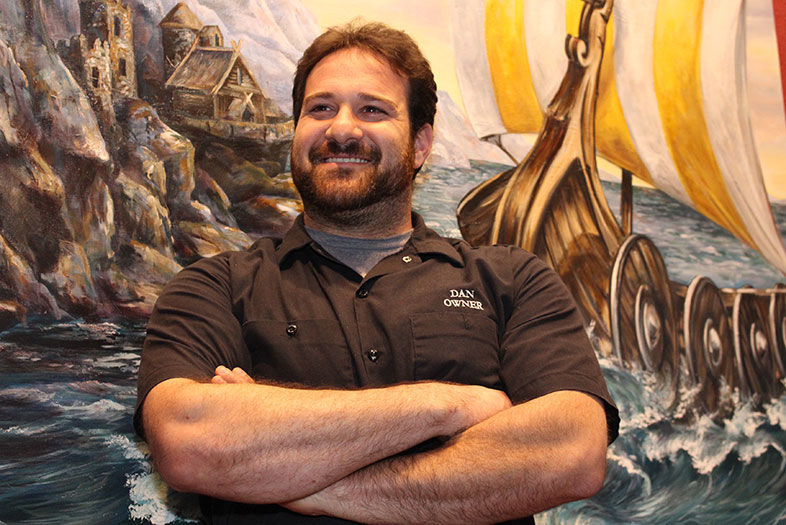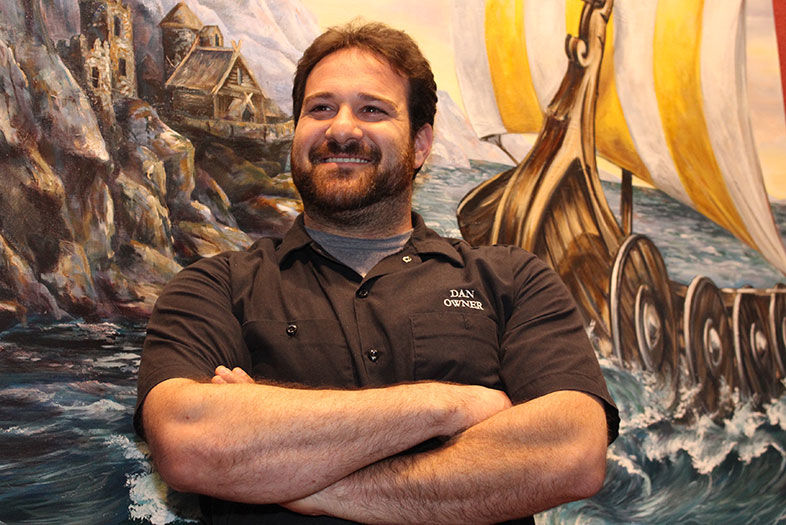When Longship first opened its doors a little more than eighteen months ago, I marked them down in my little mental notebook as a “maybe.” At first glance (and tasting) they fell into the most common category of new San Diego breweries—namely, a place that does perfectly fine beer with the potential to “maybe” evolve into something outstanding.
Since my first visit, I’ve managed to keep tabs on this 10-barrel concern—I’ve tasted their beers periodically—and I’m happy to report that Longship has evolved much in the way I had hoped it would. Their beers have risen steadily in my esteem and the brewery has worked hard to garner the attention that it deserves from the craft-loving public. I decided to finally schedule a sit-down with owner-brewer Dan Jachimowicz after tasting his Althing Belgian Tripel at this year’s Guild Fest. That delicious well-done brew was one of my favorites of the day.
At the brewery, the tasting room offerings highlight even more of what Longship can do these days. Their board includes an impressive variety of interesting styles, including a gose, a Belgian wit, an American Strong Ale, a smoked porter, a Vienna Lager, an India Pale Lager, a Dunkelweizen, and a Dopplebock. They also have a nice selection of more mainstream styles, such as pale ale, IPA, red, and stout.
Sipping from a deliciously malty glass of their award-winning Ragnabock Dopplebock (silver medal at the 2017 New York International Beer Competition), I asked Dan about his brewing roots, his vision for the brewery, and what excites him most about the process of making beer.

Have a Beer with Longship’s Dan Jachimowicz
Longship created special drinking horns as part of their first anniversary celebration. | Photo by Nate Glassman-Hughes
You started out in brewing as a home brewer, is that right?
Yes. I was a home brewer before. I started right out of college. I actually had a roommate in college who did it, so I knew it was possible.
Did you brew together?
We brewed one beer together where he made a mess and had a boil over and the stuff ended up on the floor for, like, a month.
So that was the end of that partnership.
Basically. But after I graduated, I needed a hobby. I actually picked up a “Mr. Beer” kit and made a really bad lager, but I fell in love with the process. And I loved the idea of just making my own beer. So, soon after that, I started all-grain brewing, and moved on from there.
It sounds as if your roommate’s beers were pretty bad, so what was your moment of revelation when you decided that brewing your own was the way to go?
Well, I already loved good beer in college. I studied history, and my thesis was actually on the history of beer and its role in the modern world. I had also known for a while that I wanted to be in the beer industry. I did the American Brewers Guild course in 2008, at which point I wasn’t totally sure about owning my own brewery or working for someone else. I grew up with small family businesses. My parents owned their own business, so the idea wasn’t too foreign and it took some of the scary part out.
But you hadn’t actually worked at a professional brewery before starting Longship?
Part of the ABG program was a short internship at a pro brewery, which I did at Rock Bottom in La Jolla while Marty Mendiola was still there. It was a short period of time—I think it was eight weeks—but having already had all the theory and having been brewing for a few years on my own, getting the practical application in a brewery was an easy transition.
So you decided at some point after that to take a leap and start your own brewery. When was that?
It was about four years ago that I finally made the decision and got the timing, the opportunity, and the funds together to take the plunge.
Tell me a little bit about what your original concept for the brewery was going to be.
For the beers I was going to brew, I kind of took a page out of the Rough Draft playbook where you have your core lineup of four or five beers and then a bunch of rotating styles. That kind of got a little out of hand here! I did want to stick to 8 or 10 beers at a time, but now I think we’re up to, like, 15!
It’s weird. When we first opened, I had two beers that I thought were going to be our core beers. They were a pale ale and a Belgian IPA, but we don’t do those any more. Those two were great beers, but the demand for them just wasn’t quite what I expected. The only original core beer that we still have is the Abomination (American Strong Ale). The Odin Son Series that we have now is based on my original pale ale—it’s a nice, malty, balanced beer where we can play with hops. It’s a super easy-to-drink beer. The compliment we get most often for all of our beers is that they’re really well balanced. And that’s very important.

Have a Beer with Longship’s Dan Jachimowicz
ShieldWall IPA is the brewery’s top selling hoppy brew. | Photo by Nate Glassman-Hughes
Do you find most of your customers going for the hoppy beers or are your customers’ palates more varied?
I think they’re more varied. ShieldWall IPA is still our best seller, but we do have a variety of tastes here. There was one month when our red ale was our number one seller. It’s important to us to keep a balance and variety of beers. As a consumer, I always found it frustrating going to a brewery and finding eight beers, five of which were IPAs. I also like doing more difficult beers that require more controlled fermentation. Our award-winning Ragnabock Dopplebock, for example, is fairly unique and tricky. Not many dopplebocks in San Diego.
Obviously, you find the dopplebocks and the lagers more satisfying to brew as a brewer, so how do you balance that with the fact that lots of folks are coming in looking mostly for the hoppy beers?
You can do complex and difficult and still be hoppy. You can still have a complex malt bill and have five or six different hops, which can be tricky. I have to say that my least favorite beer that we’ve done here was a SMASH [Single Malt and Single Hop] beer, which was just one-dimensional and very light. We did learn a lot from the hops we used—we used a new hop variety in the SMASH beer called Topaz and we learned that we need to use it for aroma and not as a bittering hop.
What’s the origin of the brewery’s name?
Well, I was a history major and I’ve always been fascinated by history. Originally I was actually going to be a history teacher, but all the bureaucracy in education kind of turned me off. The thing I loved about brewing was just the endless possibilities. You can change one variable and you have a whole new beer. You change the fermentation temperature and you have a whole new beer. And depending upon your combination of barley and hops, you can create something completely different. So, as many breweries as there are, and as many beers as each one has done, there are still flavors that haven’t been tried yet. It’s that discovery of new beer styles and exploring what you can do with it that really drove me to brewing itself, but it’s also something we want to embody as a brewery. That’s why it’s specifically called Longship Brewery, which gives a nod to Viking exploration and discovery. Archeologists found pre-Columbus evidence of Vikings in North America and in the Middle East and China—absolutely everywhere. So we wanted to embody that sense of adventure and exploration.
Did the Vikings brew beer?
They did. They had ale and all kinds of variations of it. Of course, they also had mead, which is more commonly associated with them. And, as with most countries at the time, wine was the “highest class” beverage that was produced; that’s left over from the Romans. We haven’t yet done any of the historical types of beer that they did, mostly because they require a couple of types of herbs I’ve never heard of before!
What are some of the things that excite you most right now in your quest to explore new flavors and styles?
I’m always especially excited about yeast. When a new yeast strain comes out it’s always very interesting to see the possibilities of what you can get out of it. Even using uncommon hops, like the Topaz, and doing our Oden Son pale ale series with all kinds of different hop varieties allows us to go in different directions and explore. The first one was mostly herbal with some citrus notes, but the next one in that series will be piney and earthy and foresty, almost. The important part is keeping it balanced and keeping it drinkable. The way I measure a successful beer is not whether you can drink one pint, it’s whether you can drink two!

Have a Beer with Longship’s Dan Jachimowicz
PARTNER CONTENT
Dan Jachimowicz is Longship’s founder and brewer. | Photo by Nate Glassman-Hughes












